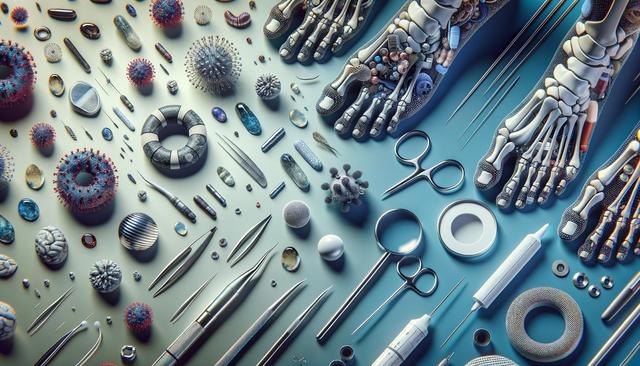Advancements in Regenerative Medicine
One of the most promising developments in the treatment of foot lesions by 2025 is the integration of regenerative medicine techniques. These include therapies that utilize stem cells, platelet-rich plasma (PRP), and tissue-engineering technologies to repair damaged skin and underlying tissues. Unlike traditional approaches that focus on symptom management, regenerative therapies aim to restore the structure and function of the injured area. Scientists are exploring the use of autologous stem cells—those harvested from a patient’s own body—to stimulate natural healing processes. These treatments have shown potential in early trials for accelerating wound closure and reducing the risk of chronic complications.
For people suffering from diabetic foot ulcers or pressure sores, regenerative therapies offer several benefits:
- Improved tissue regeneration and faster healing time
- Reduced need for antibiotics or invasive surgeries
- Lower incidence of infections and amputations
As these methods become more refined and accessible through clinical practice, they are likely to be among the most highly regarded options for treating foot lesions in the near future.
Smart Dressings and Wearable Technology
Smart dressings are another innovation expected to gain traction by 2025. These advanced wound care products go beyond conventional bandages by incorporating sensors and responsive materials that adapt to the wound environment. Some smart dressings can monitor temperature, pH levels, and moisture to provide real-time data about the healing process. This allows healthcare providers to make more informed decisions without needing to remove the dressing, which can disturb sensitive tissue and slow healing.
Wearable technology is also complementing these smart materials. Devices worn on the foot or ankle can continuously monitor pressure distribution, gait, and activity levels. This information is particularly useful for patients with neuropathy or vascular conditions, as it helps prevent the formation of new lesions by identifying high-risk areas. Key features of these wearable systems may include:
- Wireless connectivity for remote monitoring
- Alerts for early signs of pressure-related damage
- Integration with patient health records for coordinated care
These digital health tools are expected to play a vital role in personalized treatment strategies and preventive care.
Biologic Therapies and Topical Innovations
Biologic therapies, including growth factors, enzymes, and cytokines, are being increasingly studied for their effectiveness in promoting skin and tissue repair. These agents can be applied topically or delivered through injectable methods to stimulate the body’s healing mechanisms. In many trials, biologic substances have shown encouraging results in reducing healing time for chronic foot lesions.
Innovative topical treatments are also evolving. Formulations that combine antimicrobial agents with substances that promote cell regeneration are being introduced to the market. These may include:
- Hydrogel-based dressings enriched with silver or iodine
- Ointments containing peptides or amino acids
- Barrier creams that protect healing tissue from external contaminants
These products are designed to address both infection control and tissue repair, making them a comprehensive solution for managing complex foot wounds. As more data becomes available, these topical and biologic therapies are expected to become standard components of multidisciplinary care plans.
Customized Orthotics and Offloading Devices
Foot lesions often result from abnormal pressure or friction, particularly in patients with biomechanical irregularities. Customized orthotics and advanced offloading devices are playing a larger role in both treatment and prevention. By redistributing pressure away from vulnerable areas, these tools allow lesions to heal while minimizing the risk of recurrence.
Recent advancements in 3D scanning and printing technology have made it possible to create highly personalized orthotics based on real-time foot measurements. These devices offer:
- Precise pressure relief in critical zones
- Enhanced comfort and fit compared to over-the-counter solutions
- Integration with digital gait analysis for optimal performance
In addition to insoles and braces, offloading footwear and mobility aids like knee scooters are being refined to provide better support during the healing process. These tools are especially beneficial for individuals recovering from surgical debridement or those with limited mobility.
Multidisciplinary and Telehealth Approaches
Effective foot lesion treatment increasingly involves a team-based approach. By 2025, multidisciplinary care models that include podiatrists, wound care specialists, endocrinologists, and physical therapists are expected to be more widely adopted. These teams work together to address the underlying causes of foot lesions—such as poor circulation, neuropathy, or metabolic disorders—and to develop comprehensive treatment plans.
Telehealth is also reshaping how care is delivered. Virtual consultations and remote monitoring tools are making it easier for patients to receive timely advice and follow-up care without the need for frequent in-person visits. Benefits of this approach include:
- Improved access for individuals in rural or underserved areas
- Ongoing monitoring of wound progress through uploaded images
- Immediate intervention in case of complications
By combining expert care with digital convenience, these models are helping to reduce hospitalizations and improve long-term outcomes for patients with foot lesions.
Conclusion: Looking Toward a More Comprehensive Future
As we look ahead to 2025, the treatment landscape for foot lesions is evolving through a blend of technological innovation, regenerative science, and coordinated care. Whether through personalized orthotics, smart dressings, or biologic therapies, the goal remains the same: to promote faster healing, reduce complications, and enhance patient quality of life. For individuals managing chronic foot conditions or those at risk of developing lesions, staying informed about these emerging treatments can be a valuable step toward better health outcomes.







